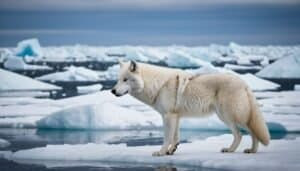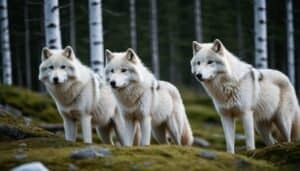Introduction
Arctic wolves, a subspecies of the gray wolf, face numerous threats that necessitate legal protections across various countries
This article explores the international agreements and national laws safeguarding these majestic animals, examines regional and local protections, highlights the role of environmental organizations, and discusses hunting regulations and habitat conservation efforts
Read on to learn about the multifaceted approach to protecting Arctic wolves globally
International and National Agreements Protecting Arctic Wolves
Protecting Arctic wolves involves a combination of international agreements and national laws. These frameworks aim to ensure the survival and conservation of this species by regulating trade, protecting biodiversity, and addressing climate change impacts
Here, we delve into the major agreements and laws that play a crucial role in safeguarding Arctic wolves
Convention on International Trade in Endangered Species (CITES)
The Convention on International Trade in Endangered Species of Wild Fauna and Flora (CITES) is a critical international agreement that regulates the trade of endangered species to ensure their survival
Established in 1973, CITES aims to ensure that international trade in specimens of wild animals and plants does not threaten their survival
Impact on Arctic Wolves:
Trade Regulation: CITES lists species under different Appendices based on the level of protection they need. Arctic wolves fall under Appendix II, which includes species not necessarily threatened with extinction but for which trade must be controlled to avoid utilization incompatible with their survival
Permit System: CITES requires member countries to issue permits for the export, import, and re-export of species listed under its appendices. This permit system helps monitor and control the international trade of Arctic wolves, ensuring it is sustainable and legal
Convention on Biological Diversity (CBD)
The Convention on Biological Diversity (CBD) is an international treaty adopted in 1992 at the Earth Summit in Rio de Janeiro
The CBD has three primary objectives: the conservation of biological diversity, the sustainable use of its components, and the fair and equitable sharing of benefits arising from genetic resources
Impact on Arctic Wolves:
Conservation Programs: Under the CBD, countries are encouraged to develop and implement national strategies for the conservation and sustainable use of biological diversity. This includes specific measures for the protection of Arctic wolves and their habitats
Protected Areas: The CBD promotes the establishment and maintenance of protected areas to conserve biological diversity. Many countries have designated national parks and reserves that serve as critical habitats for Arctic wolves
Paris Agreement and Arctic Wildlife
The Paris Agreement, adopted in 2015 under the United Nations Framework Convention on Climate Change (UNFCCC), aims to limit global warming to well below 2 degrees Celsius above pre-industrial levels
While primarily focused on reducing greenhouse gas emissions, the agreement also has significant implications for biodiversity and wildlife, including Arctic wolves
Impact on Arctic Wolves:
Climate Change Mitigation: Arctic wolves are highly vulnerable to climate change, which affects their habitat and prey availability. The Paris Agreement’s efforts to reduce global warming can help mitigate these impacts, contributing to the conservation of Arctic ecosystems
Adaptation Strategies: The agreement encourages countries to develop and implement adaptation strategies to protect vulnerable species and ecosystems from the adverse effects of climate change. These strategies often include measures to preserve the habitats and food sources of Arctic wolves.
International Union for Conservation of Nature (IUCN)
The International Union for Conservation of Nature (IUCN) is an international organization dedicated to the conservation of nature and the sustainable use of natural resources. The IUCN Red List of Threatened Species is a critical tool for assessing the conservation status of species globally
Impact on Arctic Wolves:
Red List Classification: The IUCN Red List provides detailed information on the status, threats, and conservation measures needed for Arctic wolves. This information guides policy and conservation actions at both international and national levels
Global Conservation Efforts: The IUCN collaborates with governments, NGOs, and other stakeholders to implement conservation programs aimed at protecting Arctic wolves and their habitats
National Laws Safeguarding Arctic Wolves
In addition to international agreements, various countries have implemented national laws to protect Arctic wolves. These laws focus on preserving wildlife, regulating hunting, and maintaining biodiversity
Here, we examine the specific legislation in Canada, the United States, Russia, and Norway that contributes to the protection of Arctic wolves
Canadian Species at Risk Act (SARA)
The Species at Risk Act (SARA) is a key piece of Canadian legislation aimed at preventing wildlife species from becoming extinct and providing for the recovery of those already threatened or endangered
Impact on Arctic Wolves:
Listing and Recovery Plans: SARA provides a legal framework for listing species at risk and developing recovery strategies. Arctic wolves benefit from these measures, ensuring their populations are monitored and conserved
Critical Habitat Protection: The act mandates the identification and protection of critical habitats necessary for the survival and recovery of listed species, including Arctic wolves. This helps preserve the ecosystems they depend on
US Endangered Species Act (ESA)
The Endangered Species Act (ESA) is one of the most powerful conservation laws in the United States. It aims to protect and recover imperiled species and the ecosystems they rely on
Impact on Arctic Wolves:
Species Listing: The ESA allows for the listing of species as endangered or threatened. While Arctic wolves are not currently listed under the ESA, the law provides a robust framework for their protection should their status change
Habitat Conservation: The ESA mandates the designation of critical habitat for listed species. This helps ensure that the habitats necessary for the survival of Arctic wolves are preserved and protected from development and other threats
Russian Federal Wildlife Laws
Russia has a variety of federal laws aimed at wildlife conservation, reflecting the country’s commitment to preserving its rich biodiversity
Impact on Arctic Wolves:
Hunting Regulations: Russian federal laws regulate hunting seasons, quotas, and the methods used to hunt wildlife, including Arctic wolves. Strict enforcement helps prevent overhunting and ensures sustainable populations
Protected Areas: Russia has established numerous protected areas, such as nature reserves and national parks, where hunting and other activities harmful to wildlife are restricted. These areas provide safe havens for Arctic wolves and other species
Norwegian Biodiversity Act
The Norwegian Biodiversity Act is designed to protect biological, geological, and landscape diversity in Norway through sustainable use and conservation efforts
Impact on Arctic Wolves:
Legal Protection: The act provides comprehensive protection for native wildlife, including Arctic wolves, ensuring that their populations are maintained and threats are mitigated
Habitat Conservation: Norway’s approach includes the establishment of protected areas and wildlife reserves, which are crucial for preserving the habitats of Arctic wolves. These areas help maintain ecological balance and support the species’ long-term survival
Regional and Local Protections for Arctic Wolves
Beyond national laws, regional and local regulations play a crucial role in the protection of Arctic wolves. These laws are often tailored to address specific threats and conservation needs within particular regions, providing an additional layer of protection for Arctic wolves
Provincial Regulations in Canada
In Canada, provincial governments have their own wildlife protection laws that complement federal legislation such as the Species at Risk Act (SARA)
Impact on Arctic Wolves:
Provincial Species Protection: Provinces like Manitoba and the Northwest Territories have specific regulations for the protection of wildlife, including Arctic wolves. These laws often include provisions for habitat conservation and restrictions on hunting and trade
Regional Conservation Programs: Provincial governments may also implement conservation programs that focus on preserving local ecosystems and species, including Arctic wolves. These programs are often supported by provincial wildlife agencies and non-governmental organizations
State Regulations in the US
In the United States, state governments have significant authority over wildlife management within their borders. State regulations can provide vital protections for Arctic wolves, especially in areas where federal protections might be limited
Impact on Arctic Wolves:
State Wildlife Laws: States such as Alaska have their own wildlife protection laws that include measures specifically aimed at protecting Arctic wolves. These laws regulate hunting, manage wildlife populations, and protect critical habitats
Collaboration with Federal Agencies: State wildlife agencies often collaborate with federal agencies like the U.S. Fish and Wildlife Service to implement and enforce conservation measures. This collaboration enhances the effectiveness of conservation efforts for Arctic wolves
Regional Conservation Efforts in Russia
Russia’s vast and diverse regions necessitate localized conservation efforts to address the specific needs of Arctic wolves and other wildlife
Impact on Arctic Wolves:
Regional Wildlife Reserves: Various regions in Russia have established wildlife reserves and protected areas where hunting and other activities are strictly regulated. These reserves provide safe habitats for Arctic wolves and help maintain their populations
Local Conservation Programs: Regional authorities and conservation organizations in Russia implement programs focused on monitoring wolf populations, mitigating human-wildlife conflicts, and preserving habitats. These programs are crucial for the long-term survival of Arctic wolves in specific areas
Protected Areas and Wildlife Reserves in Norway
Norway has a well-developed network of protected areas that are critical for the conservation of Arctic wolves and other wildlife
Impact on Arctic Wolves:
National Parks and Nature Reserves: Norway’s national parks and nature reserves offer protected habitats for Arctic wolves, ensuring they have access to the resources they need for survival. These areas are managed to prevent habitat degradation and human disturbance
Local Enforcement: Local authorities are responsible for enforcing conservation regulations within these protected areas. This includes monitoring wolf populations, preventing illegal hunting, and managing human-wildlife interactions
Environmental Organizations and Arctic Wolf Protection
Environmental organizations play a pivotal role in the protection of Arctic wolves by advocating for conservation policies, conducting research, and implementing conservation programs. These organizations work at both international and national levels to ensure the survival of Arctic wolves and their habitats
World Wildlife Fund (WWF)
The World Wildlife Fund (WWF) is one of the world’s leading conservation organizations, working in nearly 100 countries to protect the world’s most vulnerable species and ecosystems
Impact on Arctic Wolves:
Research and Monitoring: WWF conducts extensive research on Arctic wolf populations and their habitats. This research provides critical data that informs conservation strategies and policy decisions
Conservation Programs: WWF implements various conservation programs aimed at protecting Arctic wolves. These programs often focus on habitat preservation, reducing human-wildlife conflicts, and promoting sustainable practices in Arctic regions
Advocacy and Policy: WWF advocates for stronger wildlife protection laws and policies at both national and international levels. Their efforts help ensure that Arctic wolves receive the legal protection they need to thrive
International Union for Conservation of Nature (IUCN)
The International Union for Conservation of Nature (IUCN) is an international organization dedicated to finding pragmatic solutions to the world’s most pressing environmental and development challenges
Impact on Arctic Wolves:
Red List Classification: The IUCN Red List of Threatened Species assesses the conservation status of species worldwide. While Arctic wolves are currently classified as “Least Concern,” the Red List provides valuable information on threats and conservation needs
Conservation Action Plans: IUCN develops and supports conservation action plans for species at risk, including Arctic wolves. These plans outline specific measures needed to protect and conserve the species
Collaborative Projects: IUCN collaborates with governments, NGOs, and other stakeholders to implement conservation projects that benefit Arctic wolves. These projects often involve habitat restoration, community engagement, and policy development
Conservation of Arctic Flora and Fauna (CAFF)
The Conservation of Arctic Flora and Fauna (CAFF) is the biodiversity working group of the Arctic Council, dedicated to addressing the conservation of Arctic biodiversity
Impact on Arctic Wolves:
Biodiversity Monitoring: CAFF monitors the status and trends of Arctic biodiversity, including Arctic wolves. This monitoring helps identify conservation priorities and inform policy decisions
Policy Recommendations: CAFF provides policy recommendations to Arctic Council member states, promoting the implementation of effective conservation measures for Arctic wolves and other Arctic species
Collaborative Initiatives: CAFF works with various partners to implement conservation initiatives that address the unique challenges facing Arctic wildlife. These initiatives often focus on habitat protection, climate change mitigation, and sustainable development in Arctic regions
Hunting Regulations and Their Impact
Hunting regulations are crucial for the protection of Arctic wolves. These regulations aim to control hunting practices, set limits, and enforce penalties to ensure that Arctic wolf populations remain sustainable and are not threatened by overhunting or illegal activities
Hunting Bans and Quotas
Many countries implement hunting bans and quotas to regulate the hunting of Arctic wolves and ensure their populations are not adversely affected
Impact on Arctic Wolves:
Seasonal Restrictions: Some regions have specific hunting seasons to prevent overhunting and allow Arctic wolf populations to recover during certain times of the year. These restrictions help maintain the balance between hunting activities and wildlife conservation
Quotas: Quotas limit the number of Arctic wolves that can be legally hunted within a specified period. These quotas are based on scientific assessments of wolf populations and are adjusted to ensure sustainable management
Complete Bans: In some areas, hunting Arctic wolves is entirely banned to protect the species from declining numbers. These bans are often implemented in regions where wolf populations are particularly vulnerable
Enforcement and Penalties
Effective enforcement of hunting regulations and the imposition of penalties for violations are essential to protect Arctic wolves from illegal hunting and poaching
Impact on Arctic Wolves:
Law Enforcement: Wildlife enforcement agencies play a critical role in monitoring hunting activities, ensuring compliance with regulations, and apprehending violators. Increased enforcement efforts help deter illegal hunting practices
Penalties: Penalties for illegal hunting of Arctic wolves can include fines, imprisonment, and the confiscation of hunting equipment. These penalties serve as a deterrent and emphasize the seriousness of wildlife protection laws
Community Engagement: Engaging local communities in conservation efforts and educating them about the importance of protecting Arctic wolves can enhance compliance with hunting regulations. Community-based programs often promote sustainable hunting practices and wildlife stewardship
Protection of Arctic Wolf Habitats
The protection of habitats is fundamental to the conservation of Arctic wolves. By ensuring that Arctic wolves have access to healthy and sustainable environments, these laws and regulations help maintain stable populations and protect biodiversity
National Parks and Reserves
National parks and reserves play a crucial role in protecting the natural habitats of Arctic wolves, providing them with safe spaces free from human disturbances and habitat destruction
Impact on Arctic Wolves:
Protected Areas: National parks and nature reserves offer extensive, protected areas where Arctic wolves can roam freely without the threat of hunting or habitat loss. These areas are managed to preserve natural ecosystems, ensuring that Arctic wolves have access to prey and necessary resources
Habitat Connectivity: Protected areas often form networks that create corridors for wildlife movement. This connectivity is essential for maintaining genetic diversity and allowing Arctic wolves to migrate and adapt to changing environmental conditions
Land Use and Development Regulations
Land use and development regulations help prevent habitat destruction and fragmentation, which are significant threats to Arctic wolves
Impact on Arctic Wolves:
Zoning Laws: Zoning laws can designate specific areas for conservation, limiting development activities that could degrade or destroy Arctic wolf habitats. These regulations help ensure that critical habitats remain intact and functional
Environmental Impact Assessments: Before development projects can proceed, environmental impact assessments are often required to evaluate potential effects on wildlife and habitats. These assessments help identify and mitigate negative impacts on Arctic wolf populations
Sustainable Development Practices: Regulations promoting sustainable development practices help balance economic growth with environmental conservation. By implementing sustainable land use practices, governments can protect the habitats of Arctic wolves while supporting local communities
Climate Change Mitigation and Adaptation
Climate change poses a significant threat to Arctic wolves, affecting their habitats and prey availability. Laws and policies aimed at mitigating and adapting to climate change are crucial for the long-term conservation of Arctic wolves
Impact on Arctic Wolves:
Mitigation Policies: Policies aimed at reducing greenhouse gas emissions can help slow the rate of climate change, preserving the Arctic habitats that Arctic wolves depend on. International agreements like the Paris Agreement play a key role in these efforts
Adaptation Strategies: Adaptation strategies are designed to help species and ecosystems cope with the changing climate. These strategies may include habitat restoration, the creation of wildlife corridors, and the implementation of conservation plans that address specific climate-related threats to Arctic wolves
Conclusion
The protection of Arctic wolves is a multifaceted effort involving international agreements, national laws, regional regulations, and the active participation of environmental organizations. Each layer of protection is crucial to ensure the survival of this species, which faces numerous threats from hunting, habitat loss, and climate change
International agreements like CITES, the CBD, and the Paris Agreement provide a broad framework for conservation efforts, ensuring that Arctic wolves benefit from global initiatives aimed at preserving biodiversity and mitigating climate change
National laws in Canada, the United States, Russia, and Norway further strengthen these protections by implementing specific measures tailored to the needs of Arctic wolves within their territories
Regional and local regulations, such as provincial laws in Canada and state regulations in the United States, add another layer of protection, addressing the unique challenges faced by Arctic wolves in different areas. Environmental organizations like WWF and IUCN play a vital role by conducting research, advocating for stronger policies, and implementing on-the-ground conservation programs
Hunting regulations are critical to managing and sustaining Arctic wolf populations. By enforcing hunting bans, setting quotas, and imposing penalties for illegal activities, these regulations help prevent overhunting and ensure that Arctic wolves can thrive in their natural habitats
Lastly, protecting Arctic wolf habitats through national parks, reserves, and sustainable development practices is essential. These efforts preserve the ecosystems that Arctic wolves depend on and help mitigate the impacts of climate change
Overall, the combined efforts of international bodies, national governments, regional authorities, and conservation organizations are crucial for the effective protection of Arctic wolves. By continuing to strengthen and enforce these protections, we can ensure that Arctic wolves remain a vital part of the Arctic ecosystem for generations to come










